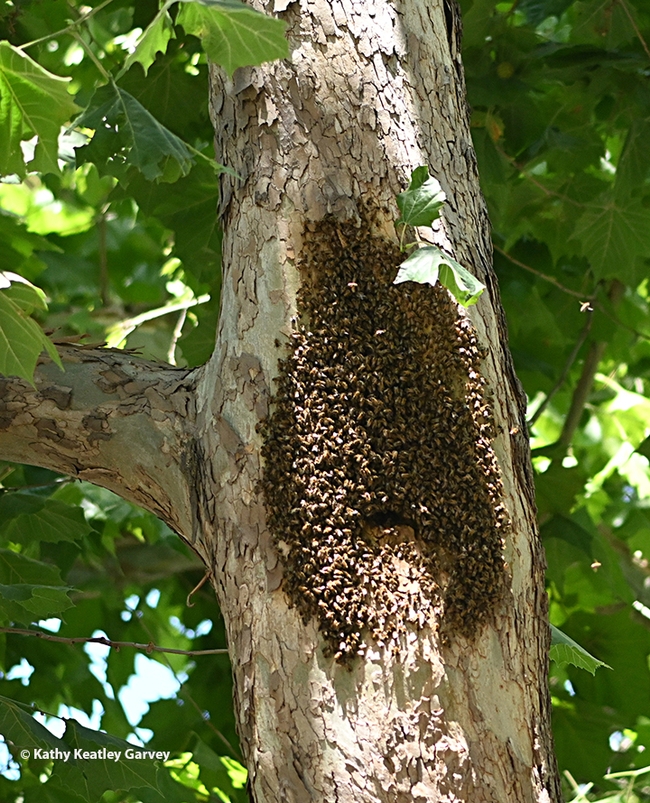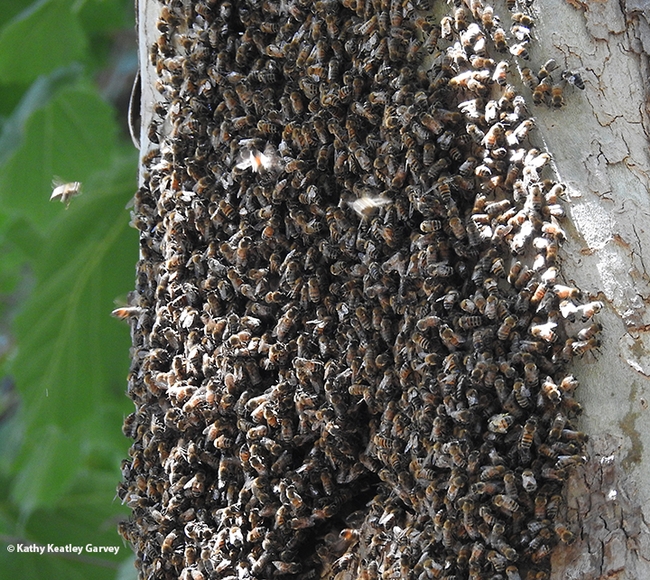Have you read the excessive heat warnings and the guidelines to prevent heat illnesses as triple-digit temperatures hold us hostage in Yolo and Solano counties and elsewhere?.
UC Davis Safety Services related this week:
- Know the signs and symptoms of heat exhaustion and heat stroke.
- Keep potable water on hand at all times for consumption. It is recommended to ingest approximately four 8-ounce cups of fresh water per hour
- Cool off in well shaded or air-conditioned areas.
- Wear lightweight, loose-fitting and light-colored clothing.
- If possible, stay indoors and avoid strenuous work during the hottest part of the day.
- Minimize direct exposure to the sun whenever possible and wear sunscreen to prevent sunburn.
- Never leave children, disabled adults, or pets in parked vehicles.
- Listen to local weather forecasts and stay aware of upcoming temperature changes.
But what about the feral honey bee colonies?
All honey bee colonies must maintain a temperature of 94 degrees, or the brood (eggs, larvae and pupae), will be adversely impacted, as the late Extension apiculturist Eric Mussen (1944-2022) of the UC Davis Department of Entomology and Nematology used to say. When the inside temperature rises above 94 Fahrenheit, bees resort to (1) bringing more water into the colony to cool it down and (2) bee bearding, meaning that some of the adults will leave the colony and "beard" just outside the entrance to help reduce the heat load inside. The "bearders" are helping their brothers and sisters-to-be survive.
That said, it was interesting this week to see the bee-bearding phenomenon on a feral honey bee colony in a sycamore tree on the UC Davis campus. Most people and bicyclists wouldn't notice it, unless they're inclined to look up 30 feet.
Bees know what they're doing,. and they've been bearding for millions of years. So, no poking, no prodding, no choking them with smoke, no dousing them with water. Or worse, what if a passerby panics and calls an exterminator?
Just leave 'em alone. The bees know what they're doing.
They're engaging in thermoregulation. When the temperature drops below 94, they'll cluster and shiver their wing muscles to keep the colony warm. If the temperature rises above the required temperature, the worker bees will gather more water and deposit the droplets inside the hive so other bees can fan and cool the colony. Bearding is part of the process.
As Mussen told us: "Like most other animals, the bodies of honey bees are mostly water. Thus, they need to drink water routinely as we do. Additionally, water (or sometimes nectar) is critical for diluting the gelatinous food secreted from the head glands of nurse bees, so that the queen, developing larvae, drones, and worker bees can swallow the food. They use water to keep the brood nest area at the proper relative humidity, especially when it gets hot and dry outside the hive. Water droplets, placed within the brood nest area, are evaporated by fanning worker bees and that cools (air conditions) the brood nest area to keep the eggs and developing brood at the critical 94 degrees Fahrenheit required for proper development."
"On extremely dry, hot days, all bee foraging except for water will cease," Mussen noted. "Under those conditions it has been estimated that the bees may be bringing back nearly a gallon of water a day."
We could learn a thing or two from the bees.
(See the bee activity on this UC Davis campus 'bee tree' on a YouTube video)
Attached Images:

As temperatures soar, feral honey bees engage in bearding to reduce the heat load inside. These bees are in a sycamore tree on the UC Davis campus. (Photo by Kathy Keatley Garvey)

Honey bees buzz in and out of their colony inside a sycamore tree on the UC Davis campus. Bee bearding helps reduce the heat load inside. Honey bee colonies require a temperature of 94 degrees for the developing brood. (Photo by Kathy Keatley Garvey)